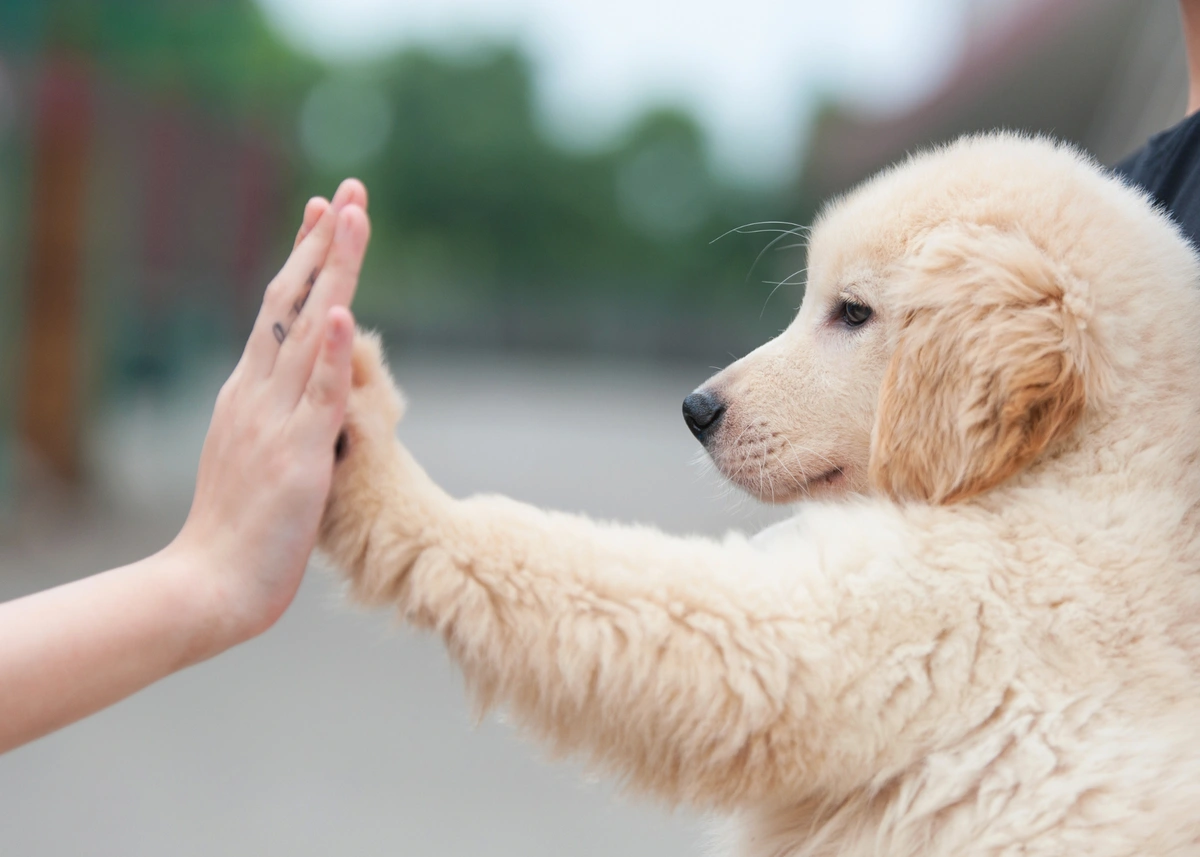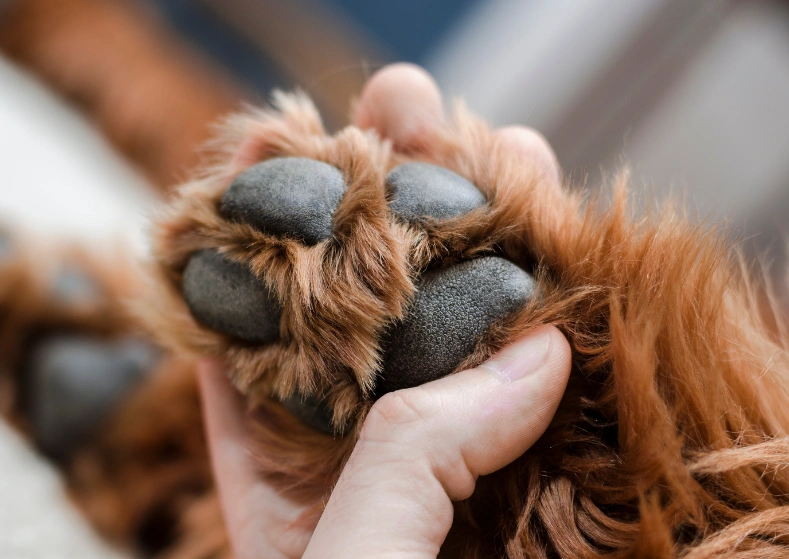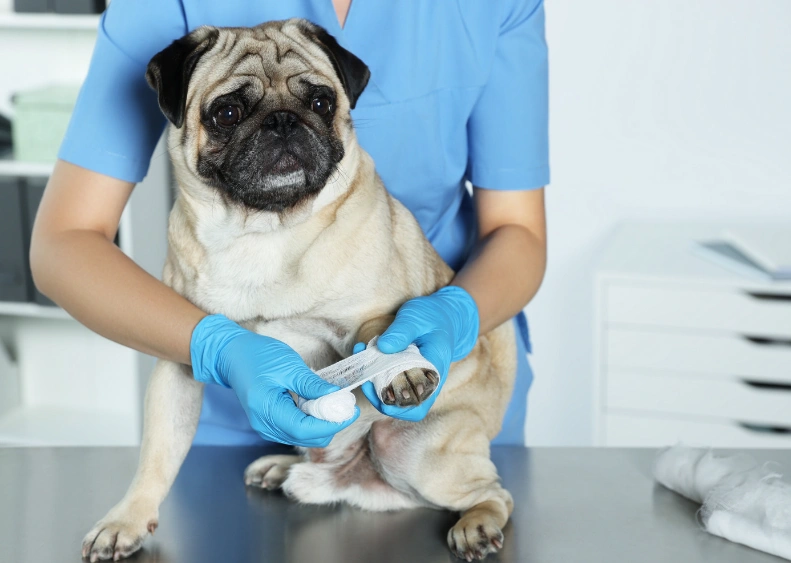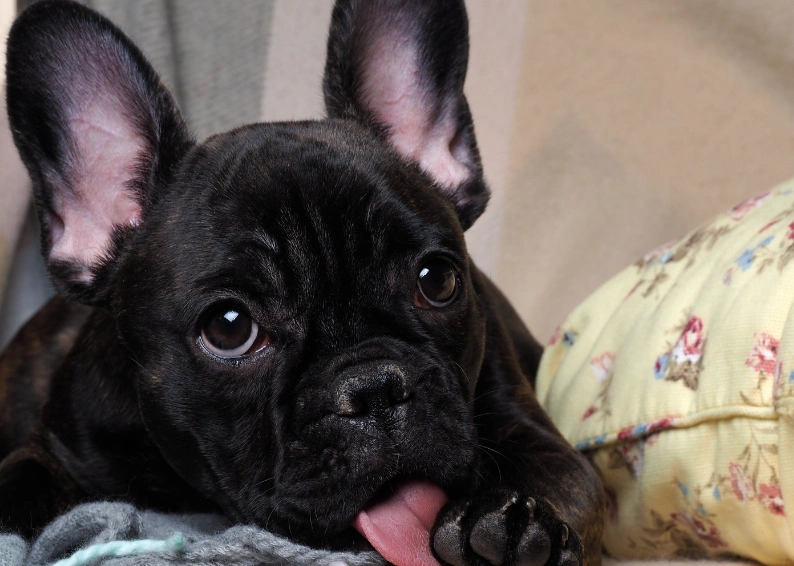“Hive five!”
Your puppy reaches out its giant paw to give you a high five, successfully following through with the fun trick you’ve been trying to teach him.
But as you reward him with a treat, you notice the bottom of his paw seems to have a cut, and you see some cracks. You feel a bit embarrassed because you must have missed this somehow. You’re wondering why your dog’s paw is hurt and how can you fix it.
Dog paw care is an essential part of your puppy’s overall health and well-being. By properly using preventative measures, regular inspection, and quick treatment, you can help ensure that your puppy’s feet stay strong and healthy.
Neglecting dog paw and foot care can lead to painful conditions, making walking unbearable for your furry friend. Learn about common dog paw issues and how to care for your puppy’s paws so you can help your puppy put its best paw forward.
Why Healthy Dog Paw Pads are Important
Dogs have paw pads to provide essential protection and support. These thick, cushioned surfaces serve as shock absorbers, helping dogs navigate various terrains with reduced impact on their joints and bones. Paw pads offer traction, enabling puppies to maintain stability and balance while walking, running, or playing. These specialized pads also provide insulation from hot or cold surfaces and contain sweat glands that assist in temperature regulation.
If you’re wondering, “How do dogs keep cool?” you’ll notice that dogs don’t sweat from the same places on their bodies as humans do. They have two types of sweat glands: Merocrine glands and apocrine glands. While the apocrine glands are located all over the body and mainly release pheromones, the merocrine glands are the ones that are most human-like and keep your puppy cool.
Dogs sweat through their paws as one of their cooling mechanisms. While they don't sweat profusely like humans, the sweat glands in their paw pads help regulate body temperature. As moisture evaporates from their pads, it cools them down. This is particularly important because dogs primarily cool off through panting, and paw sweating offers an additional way for them to dissipate heat, especially when the weather is hot or they're active. You’ve got to keep your puppy’s paws healthy so they can maintain a healthy body temperature.
How to Prevent Painful Common Dog Paw Issues
As puppy owners, we may accidentally neglect to inspect our dog’s paws when we give them their weekly brushing or when we’re remembering to check their ears. Make sure you add paw inspections to your routine of raising a happy, healthy puppy.
Many dog paw problems can be stopped before they even begin. Good news! There are lots of things you can do to prevent paw issues.
-
Regularly inspect your puppy’s paws for dog paw problems
-
Keep your puppy’s paws clean and dry, especially after swimming and exercise
-
Applying a pet-safe moisturizer or paw balm can help hydrate the pads and promote healing
-
Maintain clean, toxin-free spaces, especially in the garage, garden shed, or sidewalks, and clean up spills properly right away
-
Consider using dog boots to protect their paws during walks, especially in extreme weather conditions, rough terrain, or urban environments
-
Avoid walks where there is a potential for hazardous situations, like sticking to smooth surfaces during pleasant weather
Keep up with regular nail care for healthy dog feet
Regularly cutting and trimming your dog's nails is essential for their paw & foot health and comfort. Overgrown nails can cause a range of problems, such as painful ingrown nails, skeleton and posture problems, splayed toes, and altered gait, leading to joint and posture issues. Long nails may also get caught in carpets or other surfaces, causing gnarly tears or fractures. Proper nail care is especially critical for indoor dogs as they have fewer opportunities to wear down their nails naturally.
Regular nail trimming promotes paw health and helps maintain balance and mobility. Learning how to cut a dog’s nails step-by-step will give you a great overview of how to get started. Whether you take a DIY dog grooming approach or get them professionally trimmed, proper nail care is crucial for maintaining healthy dog paws and feet.
By incorporating nail trimming into your dog's grooming routine, you're ensuring a happy, active, and pain-free life for your beloved companion. Always consult a veterinarian or professional groomer for guidance on proper nail-trimming techniques.
Trim hair around the paw pads
Grooming the hair around your dog's paws is crucial for their well-being. Excess hair can trap dirt, debris, and moisture, leading to potential skin irritations and infections. Regular trimming prevents matting and discomfort during walks. It also improves their paw pad traction, reducing slips and injuries. Well-groomed paws contribute to overall hygiene, ensuring a happy and healthy pup that enjoys a more comfortable and active lifestyle.
Keep your puppy healthy overall
Another way to prevent dog paw problems is to maintain your puppy’s overall health. A balanced diet and regular exercise can keep your pet's immune system strong so that they fight off potential infections more easily.
Reasons Why Your Puppy’s Paws Are Hurt
If you find your puppy’s paws are not looking their best, here are a few causes that will help you address why your dog’s paws are hurting.
Cracked or dry dog paw pads
Cracked dog paw pads can be caused by various factors, such as dry weather, rough terrain, excessive walking, or lack of proper paw care. To care for cracked or dry paw pads, keep them dry. Specialty balms and salves soak into the skin and can eliminate cracks rather quickly, just like for a human’s feet. If the cracks are severe or show no signs of improvement, consult your veterinarian for proper diagnosis and treatment.
Cuts, scrapes, rips, and tears
It’s a given that a boisterous, energetic puppy will get a cut or tear on its paws just by exploring and romping around. To care for cut, ripped, or torn dog paws, start by gently cleaning the area with lukewarm water. Pat the paw dry and apply a pet-safe, non-stinging antiseptic ointment. Cover the wound with a clean, breathable bandage, securing it with medical tape. Limit your dog's activity to prevent further irritation. Monitor the paw for signs of infection and consult a vet for proper guidance.
Blunt force trauma
Your puppy may have bruises and wounds from accidents such as running into furniture, getting their paw caught in a door, or someone accidentally stepping on them. In this case, you may notice bruising or swelling. If the injury is really bad, always call the vet if X-rays are needed or if you suspect something is broken.
Insect stings and animal bites
Have you ever gotten a bee stinger stuck in your skin or been stung by a yellow jacket? The pain can be immense from something so small! Your puppy could have stepped on a nest and disturbed an angry colony, causing a bite. We’ve even seen a duck chase and nip at a puppy’s heels! Ouch!
If your puppy has been attacked or bitten by an insect or animal, clean the wound right away and see if you can remove any stingers you see. Depending on what bit your puppy, you may want to call your vet. Otherwise, treat the wound as you would with a scrape or cut, and keep an eye on it to see that it doesn’t swell even more or get infected.
Chemical burns
Because puppies are so curious, they can get into all sorts of substances on the ground, especially when roaming around off-leash or on a long lead. It’s easy for your puppy to walk right through it before you can pull or call them away.
A chemical burn is a result of your puppy’s paws coming into contact with toxic substances (usually liquids) ranging from alkalis to acids, such as solvents, oxidizers, or anything else that’s corrosive. Common chemical burns on dogs’ paws occur during winter with de-icing products like rock salt, spilled items in garages, walking through industrial areas, or places in nature where people have dumped unwanted toxins irresponsibly.
In addition to severe irritation, chemical burns on your puppy’s paws can be more serious and cause shock, respiratory issues, a heart attack, or even death.
Immediately call your veterinarian if you suspect your puppy has gotten any toxic substances on his paws. Run cool water over the paws for several minutes to try and remove what you can until you await further instructions from your licensed veterinarian.
You can do your best to avoid chemical burns by keeping your puppy on a leash, cleaning up any spills you make, keeping harmful substances away from your puppy, and being present while walking your dog.
Allergies and yeast & bacterial infections
Yeast and bacterial infections are often characterized by red and inflamed paws. Your pup may also try to lick or chew their feet excessively, which can lead to secondary infections and further irritation.
If you've ever been nearby your pup's paws and noticed a faint, corn chip-like smell, it could be due to yeast infection. When a dog’s paw pads become inflamed or irritated, the warm and moist environment leads to a fungal overgrowth of yeast.
Have you ever smelled Fritos in your house even though you haven’t had the crunchy corn chips in years? Check your puppy’s paws! The overgrowth of yeast produces a type of fatty acid known as propionic acid, which is commonly found in processed food like Frito chips! This reaction is why your dog’s paws smell like Frito corn chips!
If your dog’s paw pads are smelly, itchy, and visibly irritated, take them to a vet for diagnosis. Your veterinarian will likely recommend topical solutions like antifungal shampoos or ointments.
Keep in mind that yeast infections can also be caused by allergies, so make sure to talk with your vet about possible underlying causes. If you notice inflammation spread beyond the paw pads, it could mean a bacterial infection and other treatments may be needed.
Pawrade Puts Our Best Paw Forward For You
We partner with amazing, reputable breeders who are experts in raising healthy puppies to provide homes with wonderful, loving families like yours. All of our puppies are covered under a comprehensive health guarantee which covers both you and the breeder in case of any health issues that may arise.
We know you will do your best to keep your puppy on the right path to health when they come home to you, and paw care is part of that process. We’re here to take you one paw forward by bringing home your new furbaby. Check out our puppies for sale, and please let us know which one will pawsitively impact your life!




